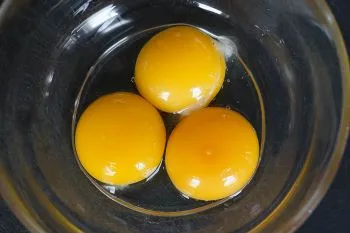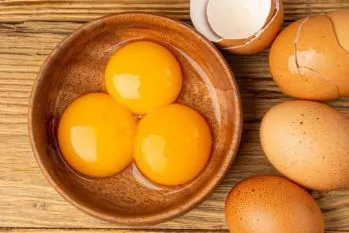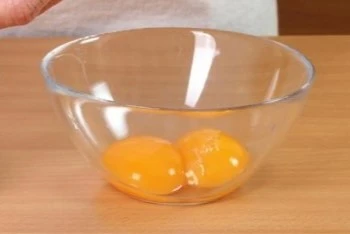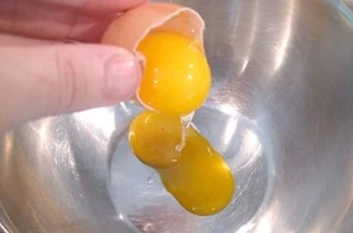This site uses only a few technical cookies necessary for its operation. By continuing to browse, you accept their use.
To find out more...
To find out more...
Preserving egg yolks

If you're using only the egg whites in a recipe (such as meringues ), you'll need to store the yolks until you're ready to use them again.
There's nothing very complicated about this in principle - all you have to do is chill them, but there are a few pitfalls to be avoided in practice.
There's nothing very complicated about this in principle - all you have to do is chill them, but there are a few pitfalls to be avoided in practice.
8,092 5/5 (35 reviews)
Keywords for this post:YolkEggStorageFridgeColdLast modified on: June 18th 2024
Preserving egg yolks
Intact yolks if possible
Here's something to keep in mind: whole, or intact, yolks keep much better than if they're punctured, or liquid.This is because the thin film that forms them, the membrane, also protects them from the outside, and prevents them from drying out.
So, as long as possible, keep them in their intact form, even if in your next recipe you'll have to crack them to incorporate them. It's best to do this at the last minute.
The enemy of yolks: dryness
The simplest and most natural way to chill yolks is to put them in a ramekin (or other small container), and place it in the fridge.
Well-preserved yolks
So how do you keep your yolks in good condition?You just need to do 2 things:
1) Put 1 teaspoon of neutral oil or even water in the bottom of the container before the yolks, then pour in the yolks.

2) Wrap the container with the yolks at all costs, or use a container with a lid, to isolate them from the air as much as possible.
Don't worry either, if you get one or more yolks punctured, it's no big deal, just a little less easy to handle, as the liquid yolks are very thick and sticky, and you'll have a bit of trouble emptying the container completely without loss (a maryse will be almost indispensable).

To sum up: try to keep your yolks intact, in a filmed or closed container, over a teaspoon of oil or water to prevent them from sticking.
Lasts posts
Butter vs. grease
We often read in a recipe where a pastry is put into a mould that, just before pouring, the mould should be buttered or greased. But what's the difference between these 2 terms?December 1st 20259165
Getting out of the fridge early
Very often when you're cooking, you need to take food or preparations out of the fridge, to use them in the recipe in progress. There's nothing tricky about this: you just take them out of the fridge and use them, usually immediately, in the recipe. But is this really a good method?November 24th 20251,0675
Who's making the croissants?
When you look at a bakery from the outside, you naturally think that in the bakery, the bakers make the bread, and in the laboratory, the pastry chefs make the cakes. It's very often like that, with each of these professions having quite different ways of working, but sometimes there's also one...November 23th 2025963
Oven height
When we put a dish or cake in the oven, we naturally tend to put it on the middle shelf, and that's what we usually do. But in some cases, this position and height can be a little tricky, so let's find out why.October 8th 20252,6465
The importance of sieving
In recipes that use a fine powder (flour, powdered sugar, etc.), you'll often see the advice to sift before using it. To sift is to pass the powder in question through a sieve (a very fine strainer) before incorporating it into your recipe. It's often advice, but is it really useful?September 3rd 20257,4723
Other pages you may also like
The 3 kinds of meringue
Meringue – what could be simpler? Just beaten egg whites with sugar added. This makes a fairly stiff mixture which can then be cooked in a cool oven to create those lovely, light confections. But in the world of professional patisserie, meringue comes in three different kinds. Even if the...June 14th 201364 K4.5
Making the most of seeds: Dry roasting
In cooking, and particularly in baking, there are a lot of seeds we can use, such as linseed, sesame, poppy, etc. Usually, recipes simply say to add them just as they are to the mixture or dough. To make a seeded loaf, for example, prepare a plain bread dough as usual, then, towards the end of...January 30th 201562 K4.0
Cleaning endives
If you buy your endives elsewhere than in supermarkets, and in this case the best is of course from a market gardener, he or she is the one who planted and harvested them, in this case you will have endives full of earth or sand, depending on where they were grown, which is normal and reassuring, we...March 24th 202026 K4.6
Croutons
Do you use croutons, that typically French trick of toasting small pieces of bread on the side to add to a recipe? They're just delicious, but you need to know 2 or 3 things about them. .December 30th 202010 K5
The French baguette and UNESCO
As you may have already read here or there, France has initiated for some time the procedure to try to have the French baguette classified as an intangible world heritage by UNESCO. When you put it like that, it sounds a bit namby-pamby, and it would be tempting to imagine an American (for...March 18th 202015 K4.9
Post a comment or question
Follow this page
If you are interested in this page, you can "follow" it, by entering your email address here. You will then receive a notification immediately each time the page is modified or a new comment is added. Please note that you will need to confirm this following.
Note: We'll never share your e-mail address with anyone else.
Alternatively: you can subscribe to the mailing list of cooling-ez.com , you will receive a e-mail for each new recipe published on the site.









